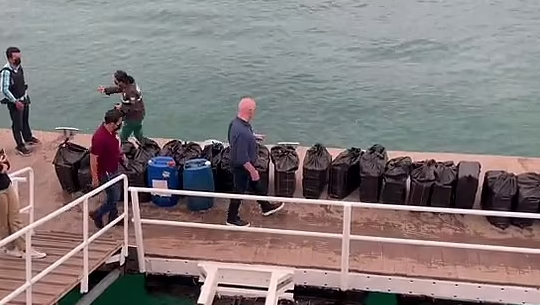Share This Article
According to Danny Rueda Córdova, Director of the Galapagos National Park, and to information from the Santa Cruz Prosecutor’s Office, on Friday, September 24, 2021, during a routine patrol at 8am, rangers from the Isabela Technical Unit (UTI, in Spanish) of the Galapagos National Park Directorate (GNPD) found the remains of 15 giant tortoises killed and slaughtered in the La Gorra sector, a rural area east of the Sierra Negra volcano, 16 kilometers from Puerto Villamil. Two of the tortoises had recently been murdered. They had been butchered. Of both, only the back (dorsal part of the shell) with the large intestine attached and the separated plastrons (ventral part of the shell) remained.
In the event report presented by the GNPD, through the UTI, to the Judicial Police, the names of Klever Enrique Gil Jaramillo and Jacinto Ramón Pinargote Pomboza appear as the rangers who found that slaughtering center.
They were probably the ones who took the photographs of the slaughter, which went viral and reached the authorities of the National Assembly and the Ministry of the Environment, Water and Ecological Transition (MAATE, in Spanish). But for unknown reasons, in that news report there was no mention of another park ranger who, according to UTI staff, would also have been there at the time of the finding, Máximo Mendoza Yépez.
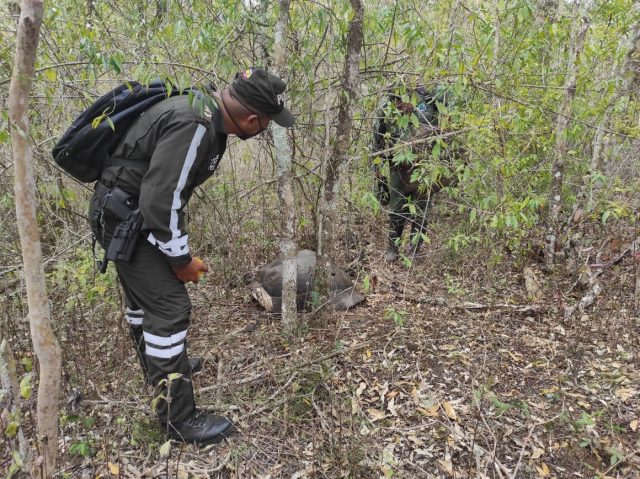
The 15 Galapagos tortoises killed were Chelonoidis guntheri, a species listed as critically endangered by the International Union for Conservation of Nature (IUCN). In chapter 20 of the book Galapagos Giant Tortoises, by James Gibbs et. al., published in 2020, it is estimated that the population density of giant tortoises should normally be 2.5 adult giant tortoises per habitat hectare.
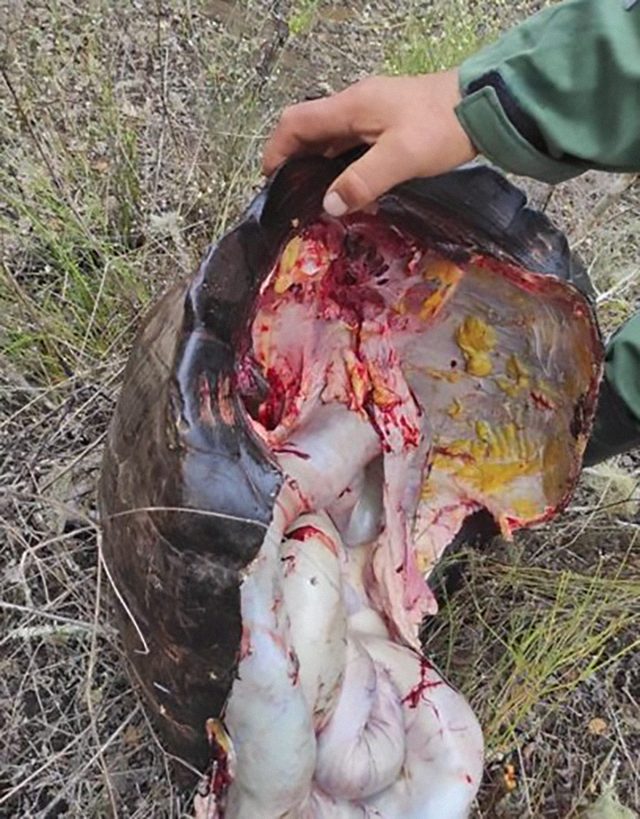
The habitat area calculated for Chelonoidis guntheri is large, 170 km2 which comprise high and low areas around the Sierra Negra volcano and where, based on the calculation, there should be 42 500 tortoises. But, as mentioned in this chapter of this book, in the last population census of this species, carried out in 2006, only 286 individuals were found in the field and an approximate 572 tortoises was estimated throughout their habitat. After that census, done 16 years ago, currently the population size of the species is unknown.
However, as detailed in chapters 19 and 20 of Galapagos Giant Tortoises, due to the invasive species that currently prey on Isabela’s giant tortoises and their eggs, such as fire ants, rats, pigs and dogs, to those that compete for food with giant tortoises such as feral cows, and mainly due to poaching, the number of surviving Chelonoidis guntheri individuals could be very small.
It is also worth mentioning that in recent years, the theft of juvenile Chelonoidis guntheri and Chelonoidis vicina tortoises (giant tortoises of the Cerro Azul volcano catalogued as endangered by the IUCN) from the Arnaldo Tupiza Chamaidán Breeding Center in Isabela for international species trafficking entails serious problems for conservation. These two species, emblems of Isabela and Ecuador, are a few steps away from disappearing forever and the causes are well known by scientists and also by GNPD and MAATE officials.
The authorities of these institutions know that the giant tortoises of the south of Isabela, Chelonoidis guntheri and Chelonoidis vicina, are becoming extinct mainly because of the clandestine consumption of giant tortoise meat by a minority of the Isabela Island population.
In Galapagos, the slaughter of giant tortoises has been prohibited since 1933. Currently, killing an animal of an endangered species is a crime typified in article 247 of the Integral Criminal Organic Code of Ecuador (COIP, in Spanish) as a crime against the country’s flora and fauna. However, in Isabela, unlike the rest of the Galapagos province, the slaughter of giant tortoises continues taking place in the sight of the competent public agencies.
According to the information obtained in this journalistic research, one of the possible reasons for the lack of action on behalf of the agencies may be related to the fact that there would allegedly be employees of the Isabela Municipal GAD (Decentralized Autonomous Government), the Galapagos Governing Council, the Agency for the Regulation and Control of Biosecurity and Quarantine for Galapagos (ABG, in Spanish) and the Galapagos National Park Directorate (UTI-GNPD) involved in these crimes against the country’s most emblematic wildlife.
At the beginning of 2022, during a visit to the Arnaldo Tupiza Chamaidán Giant Tortoise Breeding Center in Puerto Villamil in Isabela, when asking the site guide about the consumption of Galapagos tortoise meat, he explained that in the past settlers slaughtered giant tortoises to survive on the island but that no one does it anymore due to the crime it represents and the current availability of varied foods in Isabela and throughout the Galapagos.
Then the guide spoke about a program where Isabela´s children feed and take care of Galapagos tortoises to raise their awareness and prevent them from killing giant tortoises in the future.
Going back to the subject again, the guide admitted that there are fishermen who, knowing that it is a crime, still capture Galapagos tortoises, even in the north of the island, for meat consumption. However, he said it was a delicate matter and stated that if you are a snitch (and turn them in) they can even kill you… for being a good citizen and denouncing them.
Last May, in a conversation between this media outlet and Att. Christian Fárez, the first prosecutor who investigated the case of the 15 Galapagos tortoises killed and slaughtered in Isabela, Fárez revealed a significant fact: the slaughtering of giant tortoises is carried out for consumption and also for illegal meat trade among a certain group of islanders.
In conversations with residents of Isabela, who for safety reasons asked Periodismo de Investigación to protect their anonymity, we found out that 10 or 12 years ago most Isabeleños, who are now tour operators, were fishers, and that several of them used to kill Galapagos tortoises, even more than 40 Galapagos tortoises a month.
Residents say that among the people currently working in showing the value of Isabela’s natural heritage to tourists are, ironically, some of the endangered giant tortoise meat eaters.
But then, who are those who make wildlife crime a way to make money?
Isabela’s residents explained that before answering that question, legalized hunting must be understood as a transcendental issue of the problem. Surprisingly, by filling in an application at the GNPD technical units and paying USD 2.00, residents of San Cristóbal, Santa Cruz and Isabela islands can get a permit that allows them to hunt introduced species of social interest such as pigs, cows and goats on their islands, for three days, within the Galapagos National Park, as a means of controlling their populations.
But, according to Isabela’s park rangers and residents, those who hunt usually enter the protected areas with or without such permit. Now, in what way is the hunting of introduced animals performed? The use of firearms is prohibited within the National Park, but to our bigger surprise this activity is carried out with packs of hunting dogs. According to UTI officials, information from the Galapagos Giant Tortoises book, and to residents of the island, these are poorly cared for and unsterilized dogs that usually run away in the countryside and are currently invading the island’s ecosystems and further affecting Isabela’s native fauna. In fact, in the 2021 and 2022 entry control sheets to Isabela’s protected areas, the number of dogs have been recorded at the hunters’ entry, but not at their exit.
After reviewing the ecological problem posed by these hunting methods to target introduced animals, we move on to the biggest problem which, according to anonymous GNPD and resident sources and based on a 2013 GNPD internal control document, many of those hunting the pigs and feral cows of Isabela are also those who are slaughtering the Galapagos tortoises of the island and those trafficking their meat.
In Chapter 20 of Galapagos Giant Tortoises, poaching is pointed out as the main cause of the current extinction process of Chelonoidis guntheri and according to the information collected for this report, the poaching of this species is closely related to the hunting of invasive species: pigs and cows. A GNPD report on poaching on the island verbatim states that: to avoid suspicion, hunters mix tortoise meat with beef and pork, which are also hunted in the same places where these reptiles are found.
That is how, even when the GNPD knows about the killing of tortoises and the introduction of dogs to the natural environments of Isabela, the hunting of pigs and feral cows remains conceptualized as an ecosystem restoration activity, according to the 2005 Management Plan of the Galapagos National Park, as it is considered as the extraction of invasive fauna.
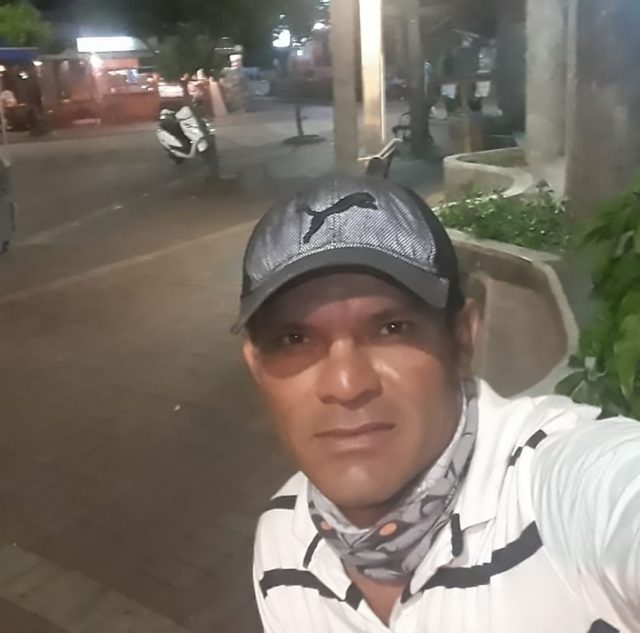
Several residents of Isabela, who are not related to each other, stated that a man named Fabricio Morocho Segura goes from house to house, offering giant tortoise meat, in Puerto Villamil. This man works as a captain of tourist boats and is the brother of Víctor Ramiro Morocho Segura.
Ramiro is a member of the Isabeleños ASSOCIATION FOR THE CONTROL AND MANAGEMENT OF INTRODUCED SPECIES, which is an unincorporated association formed by the island’s hunters. However, when Periodismo de Investigación requested information from this organization, in the response letter to the questions asked, it was explained that neither the MAATE nor the GNPD have provided the hunters with any training on the control and management of introduced species.
According to an anonymous GNPD source, many years ago, in the early 2000s, the institution carried out two invasive species control projects in Isabela in collaboration with invasive species hunters. At that time, some of those hunters were already known as giant tortoise killers.
Among the names that anonymous GNPD and resident sources stated most frequently as giant tortoise hunters and Galapagos tortoise meat traffickers in Isabela are those of the people who run the hunting association, Adolfo Flor Moya and Julio Tiler Flor Yepez, nephews of the former assemblywoman for the province of Galapagos and wife of the former mayor of Santa Cruz, Brenda Flor Gil.
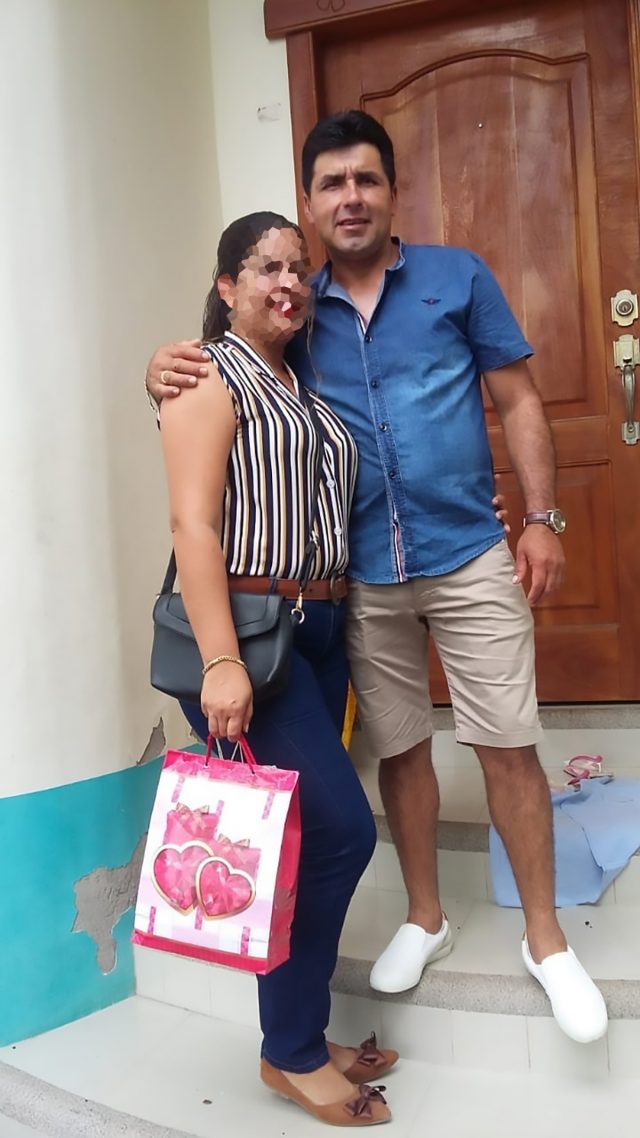
On October 6, 2021, at the 32nd Session of the Biodiversity and Natural Resources Commission of the National Assembly, after learning about the case of the 15 tortoises killed in Isabela, Galapagos assemblyman Pedro Zapata asked Environment Minister Gustavo Manrique about the actions his state portfolio would take in this regard. The Minister first replied that he wanted to see this matter as an issue of tortoise meat ancestral consumption, trying to disguise this crime as a cultural manifestation.
Then the Minister gave the floor to Danny Rueda, the Director of the National Park, who gave details about the complaint made. Nevertheless, ancestry cannot be brought to the table since the first human settlements in Isabela were in 1897 and only 36 years later the killing of giant tortoises was banned. According to the Galapagos Giant Tortoises book, those who historically exploited the Galapagos tortoises between the 16th and 19th centuries were European pirates who stopped on the islands to capture them for food.
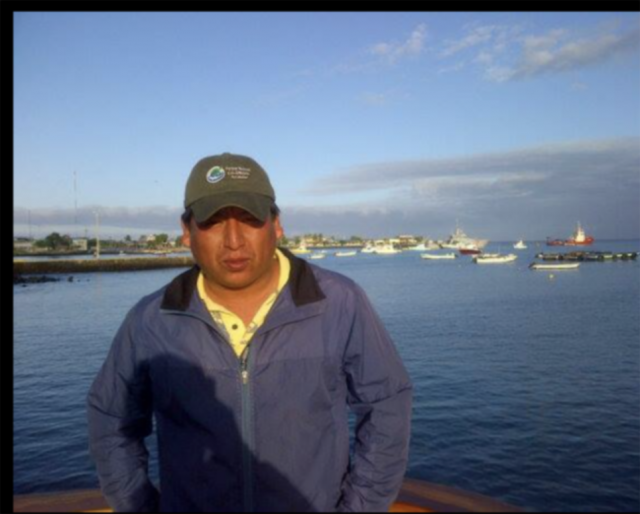
Efrén is brother of Tony Pomboza Gil, who was signed, in the DPNG report, as a trafficker of
giant tortoise meat trafficker
According to Jacinto Gordillo in his book Relatos de 44 años en Galápagos (Stories of 44 years in Galapagos,) criminal fugitives fleeing from the Colonia Penal (the Prison) that the state established in Isabela between 1946 and 1959 also consumed giant tortoise meat.
In general, the sources consulted for this report feel discomfort about what is happening with the Galapagos tortoises and agree that tortoise meat consumers are a minority among the 2 350 inhabitants of Isabela. Island sources agree that those are people who need to value the unique and wonderful nature they coexist in. Currently, the Galapagos province lives on its natural attractions. In fact, according to the Galapagos 2030 Plan of the Galapagos Governing Council, currently 51.4% of the economically active population work on tourism-related activities, which represent 64% of the provincial Gross Added Value (GAV), thanks to the archipelago’s natural wonders. And Galapagos wouldn’t be Galapagos without giant tortoises.
According to GNPD officials, who asked not to disclose their names, knowing all the hunters registered in the hunting permits and in the entry control sheets to the National Park, does not guarantee finding all those who kill Isabela’s giant tortoises there. Residents say that there are those who by land or sea enter the protected areas without permits, sometimes even from other islands, and also kill giant tortoises.
This problem is serious because those criminals are more difficult to identify and stop. According to anonymous GNDP sources, the place in Isabela where park rangers have reported most remains of giant tortoises slaughtered is the Caleta Iguana sector, habitat of Chelonoidis vicina, near the Cerro Azul volcano.
To the poaching problem, the neglect of the island in terms of security is added. Isabela is the largest island in Ecuador with 4 588 km2 in area. In comparison, the province of Tungurahua measures 3 386 km2. In a meeting with Homero Bucheli Robalino, lieutenant colonel of the Ecuadorian Air Force, on security, he explained to Periodismo de Investigación that, due to the island’s size, at least drones with a 25-kilometer range, long autonomy, with 200x cameras, thermal imagers and advanced command and control centers linked to all the relevant authorities would be necessary for proper protected area surveillance, however this technology is not currently being used.
On the other hand, sources from GNDP’s Isabela Technical Unit (UTI) assure that, on the island, the Environmental Police mainly fulfills urban patrol roles within Puerto Villamil, due to lack of police personnel. Moreover, based on a 2013 GNPD internal control report Periodismo de Investigación had access to, Isabela’s park rangers, UTI officials, are involved in crimes against the flora and fauna of Ecuador.
According to this report, dated December 20, 2013, entitled «Slaughter of giant tortoises in the south of Isabela Island», which was provided to our outlet by an anonymous GNPD official, 28 citizens including hunters, fishers, several municipal employees, an employee of the Agency for the Regulation and Control of Biosecurity and Quarantine for Galapagos (ABG) and UTI officials would be consumers of giant tortoise meat. Nine of the 28 people in the report were also SINGLED OUT INDEPENDENTLY BY DIFFERENT SOURCES.
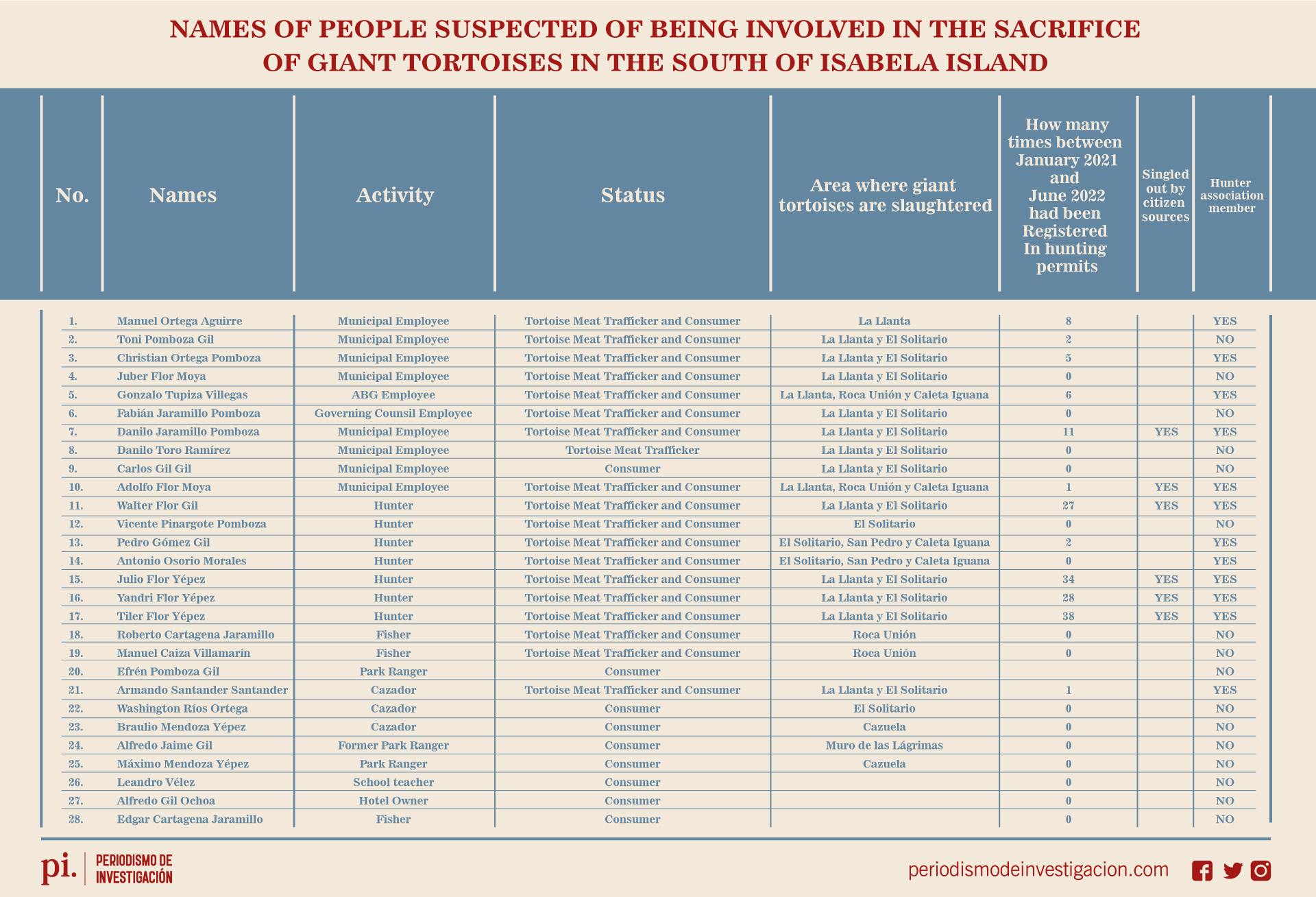
The document also identifies the sectors where 24 of the suspects would slaughter the tortoises. In addition, 19 of the 28 suspects are also identified as alleged Galapagos tortoise meat traffickers. The 2013 report explains that the price for each whole dead tortoise ranged from US$ 60 to US$ 100, within Isabela. According to anonymous UTI sources and anonymous citizen sources, those trafficking Galapagos tortoise meat currently also sell, by underground ways, cooked meat at a price of US$10 per serving.
This internal investigation report would have been reportedly sent to Arturo Izurieta, Director of the Galapagos National Park at the time, and the document would have been handed over from the General Directorate to the Police. However, the complaint never reached the courts, and no action was taken from GNPD against the UTI employees.
The report states that, since 2000, UTI has been keeping records of giant tortoises found slaughtered by humans in the field. An anonymous GNPD source stated that currently the number of tortoises killed in Isabela amounts to 353, since the beginning of the registry, but the figure corresponds only to the remains discovered and reported by park rangers.
The report points to areas that can be accessed by sea and land such as Roca Unión and Cazuela, near Puerto Villamil, and Caleta Iguana, near Cerro Azul, as the sites where most slaughtered tortoises have been found.

GNPD sources told Periodismo de Investigación that all those people in the report’s list to this day commit the same crimes, with the exception of Alfredo Gil Ochoa, who passed away. Manuel Ortega Aguirre, Tony (Toni) Pomboza Gil, Christian Ortega Pomboza, Júber Flor Moya, and Danilo Toro Ramírez are still employees of the Municipality of Isabela. Gonzalo Tupiza Villegas and Fabián Jaramillo Pomboza, both identified as Galapagos meat traffickers, keep working, the first as an inspector for ABG and the second as an employee of the Galapagos Government Council in Isabela.
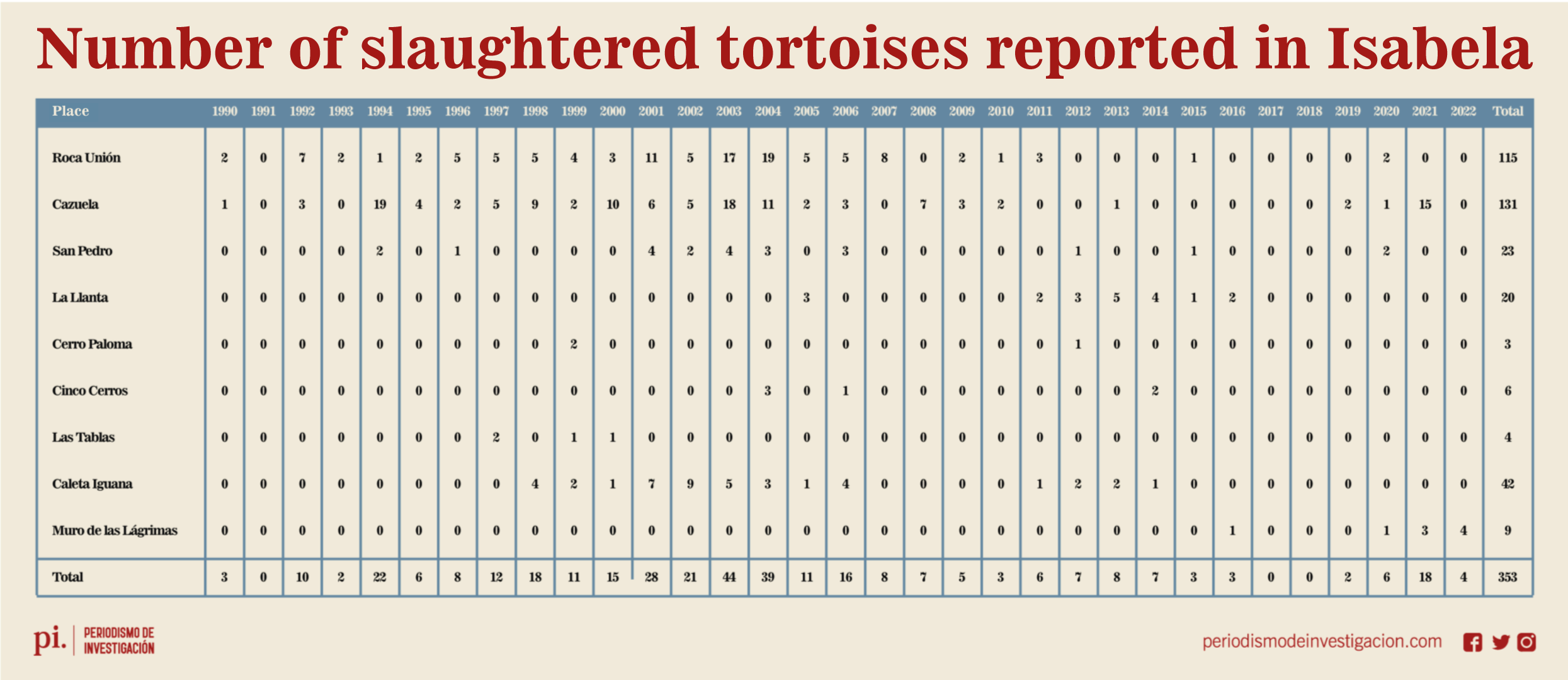
About the GNPD officials listed in the report, Efrén Pomboza Gil, an alleged consumer of Galapagos tortoise meat and who is brother of Tony Pomboza Gil, the alleged meat trafficker, currently works as the person in charge of UTI’s Ecosystem Process and is one of the officials who approve hunting permits in Isabela.
Máximo Mendoza Yépez, who, like his brother Braulio Mendoza Yépez, is listed in the document for killing giant tortoises in the Cazuela sector, continues to work as a UTI park ranger and is one of the officials who control and register the entry of hunters to protected areas in the Sierra Negra Volcano sector.
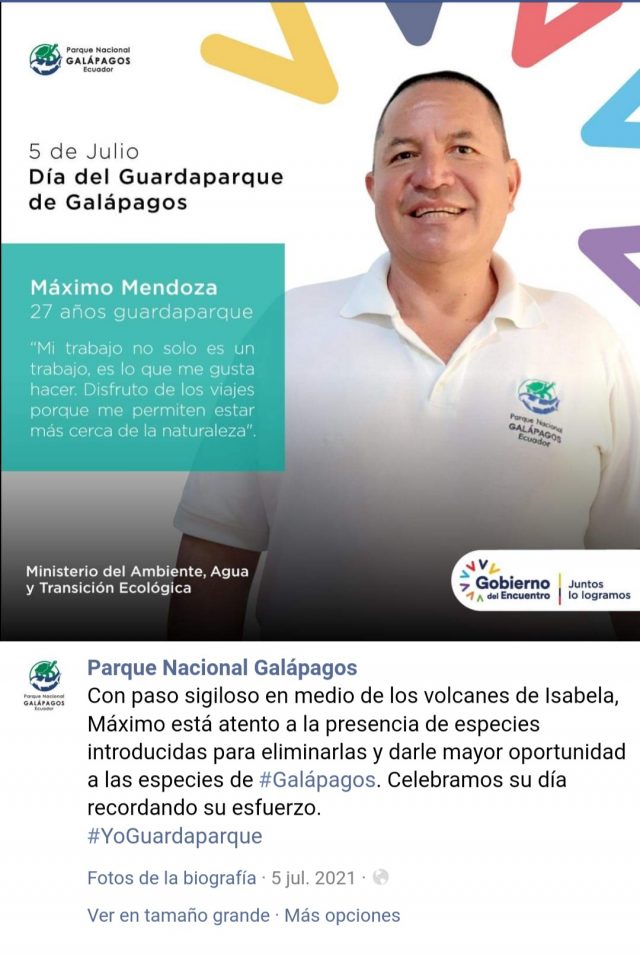
Vicente Pinargote Pomboza, a hunter accused of killing giant tortoises at El Solitario sector and of trafficking meat, is the brother of park ranger Jacinto Ramón Pinargote Pomboza. On September 24, 2021, during the discovery of the slaughter center of the 15 tortoises, in the La Gorra sector, very close to Cazuela, Jacinto Ramón Pinargote Pomboza and Máximo Mendoza Yépez were at the place. Great ironies and great coincidences.
Before completing this journalistic investigation, Periodismo de Investigación conducted a telephone interview with Danny Rueda Córdova, the current general director of the Galapagos National Park. One of the questions was about the actions that the GNPD would take if an official of the institution was involved in the slaughter of giant tortoises. The director said that every person is presumed innocent until proven otherwise in trial.
This story was produced with support from Internews Earth Journalism Network.



